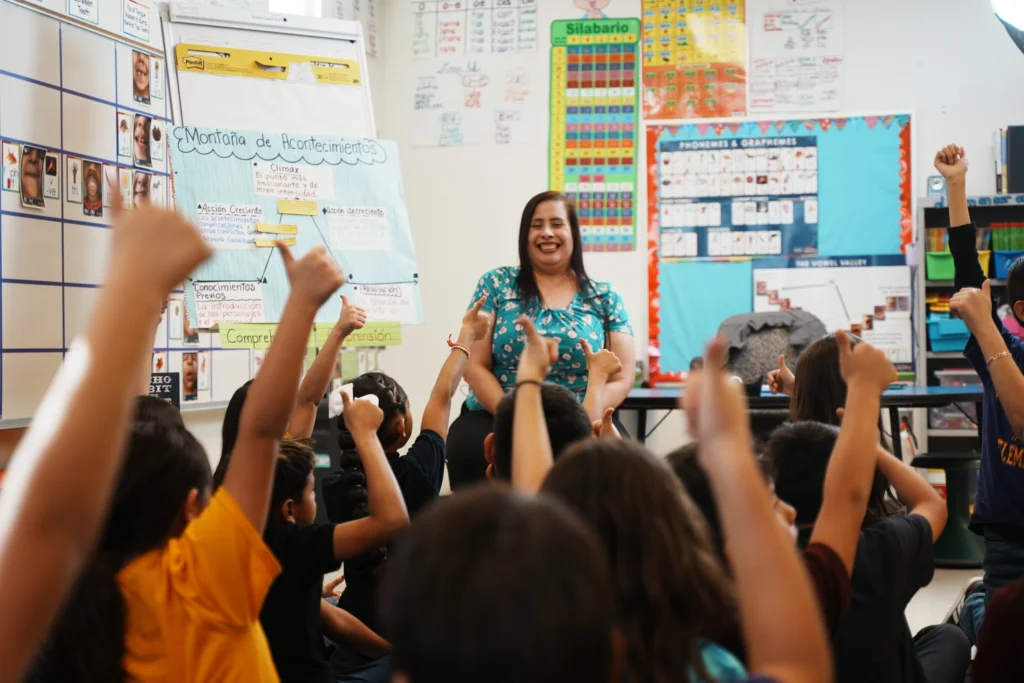- Reader’s Skill and Knowledge
5 Things to Know About Teaching Reading to English Learners

1. ELs benefit from explicit instruction.
2. Students’ prior literacy experiences matter.
3. Students’ primary languages are an asset.
Helping English Learners with Short 'i' and Short 'e'

Hide Video Transcript
Show Video Transcript
Estella Escajeda: Okay, you ready, boys and girls? Today we're going to be talking about the short 'i' and the short 'e'. Okay.
Narrator: Teacher Estella Escajeda is helping her multilingual third graders hear and produce the very subtle difference between the short 'i' sound and the short 'e' sound.
Estella Escajeda: So here we have the /ĭ/ as in itch, and then we have the /ĕ/ as in edge, like if you're at the edge of something, right? So, the /ĭ/ and the /ĕ/. Can somebody tell me, what do you notice? What do you see? Maritza?
Maritza: They're close together. [She answers in Spanish.]
Estella Escajeda: They're close together. That is correct. Do you guys notice? Look at the Vowel Valley.
Narrator: Maritza is comfortable answering in her home language, Spanish. That's because Ms. Escajeda encourages children to use all of their language resources to tackle the complex process of learning to read in English.
Estella Escajeda: So everybody, put your fingers next to your lips. Say /ĭ/ ...
Students: /ĭ/ ...
Estella Escajeda: Say /ĕ/ ...
Students: /ĕ/ ...
Estella Escajeda: What did you notice? What did you feel? Maria Eugenia?
Maria Eugenia: [The student answers the question in Spanish.]
Narrator: Ms. Escajeda provides her students with a bridge from Spanish to English by talking explicitly about the connections between the two languages.
Estella Escajeda: If you notice, when we hear /ĭ/, do we also hear it in Spanish? One of our vowels. Everybody say, icky ...
Students: icky ...
Estella Escajeda: What do you hear in the beginning?
Students: /ĭ/ ...
Estella Escajeda: Say echo.
Students: "echo" ...
Estella Escajeda: Say echo with your opera voice.
Students: echo ...
Estella Escajeda: Yes. You hear the difference? Good job.
Narrator: Next up, they'll use their new skills to take on dictation ... spelling words with short 'i' and short 'e'.
Estella Escajeda: Get your magnetic letters ready and you're going to get your boards ready.
Narrator: If you enjoyed this video, please subscribe to our YouTube channel @RUTeaching. For more information, please visit ReadingUniverse.org. Special thanks to Loma Linda Elementary School, Vado Elementary School, the Gadsden Independent School District, and the New Mexico Public Education Department. Reading Universe is made possible by generous support from Jim & Donna Barksdale, the American Federation of Teachers, The Emily Hall Tremaine Foundation, and anonymous donors. Reading Universe is a service of WETA, Washington, D.C., The Barksdale Reading Institute, and First Book.
"For ELs, phonemic activities in English can be complicated by having to recognize sounds in English that do not exist in their native language. ... Instructionally, it is important for teachers to determine some of the similarities and differences between English and the student's native language to ensure the opportunity to learn."
— Virginia Lovelace-Gonzalez, Educational Diagnostician and Certified Academic Language Therapist
4. Vocabulary instruction is key.
5. Decoding does not equal comprehension.
Common Errors by Spanish Speakers Who Are Learning to Read in English
Below are sounds that Spanish-speaking students often struggle with when they're learning to read in English, according to Virginia Lovelace-Gonzalez (opens in new window). Knowing these can help teachers prepare their lessons and anticipate places for extra instruction.
| Error | Reason |
|---|---|
| Adding /ĕ/ before ‘s’ blends | Words do not begin with ‘s’ blends in Spanish (estado is the Spanish word for state). |
| Substituting /s/ for /z/ | The /z/ sound does not exist in Spanish. |
| Substituting /y/ for /j/ | The /j/ sound does not exist in Spanish. |
| Using trilled sound /rr/ rather than English /r/ sound | There is no trilled sound in English. |
| Pronouncing short ‘i’ as /ē/ | The letter ‘i’ is pronounced as a long ‘e’ in Spanish. |
References
Cárdenas-Hagan, E. (2020). Literacy Foundations for English Learners: A Comprehensive Guide to Evidence-Based Instruction. Baltimore: Brookes Publishing.
Goldenberg, C. (2008). Teaching English Learners: What the Research Does — and Does Not — Say (opens in new window). American Educator. Retrieved from: https://www.aft.org/sites/default/files/goldenberg.pdf (opens in new window)
Lovelace-Gonzalez, V. (2020). "Chapter 4: Phonological Awareness Development Among English Learners." Literacy Foundations for English Learners: A Comprehensive Guide to Evidence-Based Instruction. Baltimore: Brookes Publishing.
National Academies of Sciences, Engineering, and Medicine (NASEM). (2017). Promoting the Educational Success of Children and Youth Learning English: Promising Futures. Washington, DC: The National Academies Press. https://doi.org/10.17226/24677 (opens in new window).
Nieser, K. and Cárdenas-Hagan, E. (2020). "Chapter 5: Phonics Development Among English Learners." Literacy Foundations for English Learners: A Comprehensive Guide to Evidence-Based Instruction. Baltimore: Brookes Publishing.
Tridas, E. (2020). "Chapter 3: Components of Literacy Instruction for English Learners." Literacy Foundations for English Learners: A Comprehensive Guide to Evidence-Based Instruction. Baltimore: Brookes Publishing.
